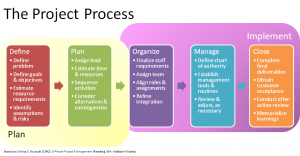“This is a project…
…So, why do we need to talk about process?” For discrete projects of enough size and risk, one of the first layers of structure to add-in to managing the project, is to think about the project as a process. The process helps define what the project’s “customer” wants. How much she is willing to pay for it, how much investment- both resources and time- is appropriate to achieve the project outcome. In a previous post we explored the scope, resources and schedule elements of every task, project and program. The steps you go through, from beginning to end, are the project process.
Eventually, changes designed during a management consulting engagement need to be implemented. Usually teams in a series of coordinated, discrete efforts focus on changing how the business goes to market. Each of those changes require sponsors and managers to lead, management commitment to steel the talent to continue on, resources to do, etc. Historically, I have reached into my consultant’s tool-kit to bring a very simple, proven approach (read process) to align executives through to the complacent observers. I believe the best project process is summarized in a book entitled 5-Phase Project Management, a practical planning and implementation guide by Weiss and Wysocki (1992). While I typically move and change many of the action steps within each of the 5 Phases, as I have in the embedded graphic, it has proven to be a great framework and aid (with one of my clients ordering a book for each of their project managers!)
Depending on the number of projects your organization is involved in, once the key action steps are in the appropriate phase, consider adding phase-level deliverables. By defining specific deliverables required for each phase your organization can create a phase-gate process, which just means you must have these deliverables completed before proceeding to the next phase (or process step). For example, you must have a work-breakdown-structure defined before you complete the plan phase (process step). Further, the common language and consistent expectation of an established process can provide a platform for continuous improvement- better and better project execution as experience increases with a consistent set of steps for those discrete, one-of-a-kind projects.
One closing thought as we explore whatever level of process you decide to help you manage project risks- the After Action Review. The armed forces have some of the best management routines for learning in an environment which is nothing but managing the unexpected. One of those management routines is to ask a simple series of questions at the completion of each action, starting with “Were we clear on our objective? Did we accomplish what we set out to do?…” You have to create a written history in order to study and ensure you do not repeat the same mistakes. Start simple and learn. The After Action Review is culturally critical to a learning organization and an important action step in the close process step.

